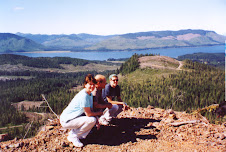Early windows with small openings and cheap poly glazing, courtesy of Bob and Gary.

All of our housing shared this attribute, sometimes with humorous results. When we first moved onto the farm, we shared two bunk beds in a small room next to Lenny and Betty. The walls were at least as good as the plastic windows for blocking noise. Lying in bed with the lights out we could wish them a good night's sleep without raising our voice. Later on we shared a cabin with the MacKenzie's with a duplex setup. While we had separate entrances, it was easy to tell what was going on in the other half. Each family generally had a potty to avoid the long walk to the outhouse on a cold winter night. We each had our own way of dealing with a full potty in the morning. My personal preference was to have the most qualified member of the family do it to avoid problems. In our family, I was the most likely to make it spill-free downstairs, out the door, along the wet board walks to the proper receptacle. Our neighbors employed the opposite approach, dictating the potty dump was in the hands of the youngest child who could walk and carry a pot for at least part of the distance. On more than one occasion, we heard the distressing sound of a child bouncing down the stairs with the bucket sharing its contents with everyone and everything in the vicinity. And yes, the outcries were easily understood.
Larger windows but still covered with 4 mil garden quality poly.
(that's me with the green plaid shirt...)

On a related issue, our waste water was safely poured out onto the absorbent muskeg surrounding the cabin. The easiest way to handle small amounts was to empty the contents out the window. Since it would be considered impolite to throw it directly on a friend passing by, we employed the standard warning employed in blasting, although we changed the exact wording to "water in the hole." If you heard that short message, you only had a short time to step out of the way.
The weather in southeast Alaska had some interesting variations. If you spent any time in the virgin forests surrounding our home, you noticed a pattern all along the bay. There were large areas of deadfalls that had all come down some ten to twenty years earlier in a storm that obviously had very strong winds from the southwest. With over 120 inches of rain each year (some of it snow), constant low-level clouds blocking the peaks over 3,000 ft. high, and quick changes in weather patterns, we were used to most of them. Our first exposure to williwaw winds came one night as we were enjoying a restful night's sleep. The first clue was the sound of a freight train off in the distance. Oddly, it was coming straight for us and kept getting louder and louder. About the time it was in our back yard, an immense wave of wind struck the cabin, emphasizing the vulnerability of our plastic windows, and shaking the whole structure. A quick check showed we were all okay, there was no damage, and we could just lie back in bed, relax and drift back off to sleep. Then the next freight train left the station headed our way. Having once experienced that fierce wind, it was impossible to sleep. The cycle continued for some time before ending. While that was not an enjoyable way to spend the night and the polyethylene seemed hopelessly inadequate to resist the assault, I was more than pleased that I was not out on the waters in a small boat when they passed by. We have been told the winds result from high pressure building up behind a mountain range until it reached the point where it would overflow, releasing an impressive wall of wind, then silence leading to another one. In Juneau they experienced the Taku winds, which came from Taku Mountain. I believe the weather station there once recorded a 230 mph wind before the anemometer was ripped apart.
It was a poignant example of how fragile we stood before nature's impressive strength, and a reminder to be thankful for our modern double-glazed windows that so faithfully hold out the winter cold.
A later installation with crystal clear poly.



3 comments:
Yikes! I can tell that this blog is going to be an eye-opener for me. I've not heard many stories about the reality of daily life on Alaskan farms, especially Hoonah. Please keep writing, Keith - looking forward to future installments.
Keep on writing! I love it!
I love your posts! And guess what--I still have the rocking chair in your picture. I can't bring myself to get rid of it.
Post a Comment